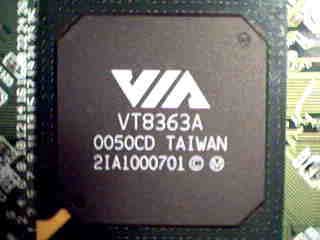Iwill KK266 Socket-A KT133A ATX
by Mike Andrawes on February 22, 2001 2:28 AM EST- Posted in
- Motherboards
Providing the Basics
The VIA 8363A North Bridge sits between the CPU socket and the AGP slot and, as the core of the KT133A chipset, provides all the major features of the chipset, including the 100 / 133MHz FSB and memory bus, as well as AGP 1X/2X/4X support. The AGP slot on the KK266 is a universal slot, meaning that you can use almost any kind of AGP video card currently available without problems. The only exception here is a card that requires the extra current capabilities of AGP Pro.
 The VIA 8363A North Bridge |
Finally, with the 8363A North Bridgewe have official support for 133MHz DDR FSB (266MHz effective) Athlons. In the past, even with 1.2GHz Athlons, you were limited to a FSB speed of 100MHz and a multiplier of 12. Now the KT133A chipset allows you to have a FSB speed of 133MHz and possibly higher, so that with the same 1.2GHz chip, you can lower the multiplier to 9, and effectively boost the overall performance while remaining at the same clock speed. It should be noted that this is considered overclocking, but we've yet to see an Athlon or Duron not handle such a configuration.
The KK266, as well as most of the recent AMD Socket-A motherboards, includes a way to change the multiplier ratio setting of a Socket-A processor. You still need to prepare your CPU for overclocking, and we have detailed instructions about how to do just that in our Socket-A Athlon/Duron Overclocking Guide. Make sure you read the guide in order to fully unleash the power of your Socket-A processor.
Like most other KT133A solutions, the KK266 has a total of three DIMM slots supporting up to 1.5GB SDRAM. The memory controller in the 8363A North Bridge allows you to run your memory at either 100MHz or 133MHz, depending on your FSB choice. When running in the 100MHz FSB range, you have the option to run your memory at host clock (FSB speed) or host clock + PCI clock. However, the chipset will only allow you to run your memory synchronously with the FSB if you set the frequency to 133MHz or higher. Officially the KT133A chipset only supports FSB:memory ratios of 100:100, 100:133, or 133:133.
The newer VIA 686B South Bridge supports Ultra ATA 100, whereas the older 686A, only supports Ultra ATA 66. The Ultra ATA 100 controller provides two IDE channels that support up to 4 IDE devices (two per channel). IDE-RAID is currently one of the hottest new features we're seeing show up on new motherboards. Iwill has noticed as well and offers a version of the KK266, known as the KK266-R, with an on-board IDE-RAID controller.
 The VIA 686B South Bridge |
The 686B South Bridge also supports two USB root hubs. The first hub provides the two traditional USB ports found at the back of the motherboard with the serial / parallel ports. The second set of USB ports are located at the front edge of the board, next to the front panel connectors. Unfortunately, Iwill does not include the necessary USB bracket to take advantage of the third and fourth USB ports, something that most other motherboard manufacturers have begun to do.
In terms of expansion slots, the 6/1/0/1 (PCI/AGP/CNR/ISA) is beautiful for the "do it yourself" user - the vast majority of AnandTech readers. As one of the smallest motherboard manufacturers, Iwill doesn't have much of the OEM market. While that's not so good for sales, it also means that they don't have to tailor the board for OEM's This has allowed them to leave off the AMR/CNR slot that has become useless for most users due to the lack of availability of AMR/CNR cards on the open market. Instead, they have gone with an ISA slot, something that is extremely useful for those of you with old ISA devices lingering around. At the same time, the six PCI slots should be more than enough for most users.
Iwill uses the C-media CMI-8738 3D 4 channel PCI sound controller for onboard sound support instead of the more common software-based AC97 audio CODEC. The controller supports a 4 channel audio through technology from CRL 3D Audio, a 32-voice HRTF-base 3D positional audio, which helps to position sound sources when using 4 channel speaker systems. This technology supports Microsoft Direct Sound 3D and Aureal's A3D interfaces, so games and applications that utilize these interfaces will be able to take advantage of the HRTF 3D positional audio. C-media is still relatively unproven, so many of you may prefer to go with a more tried and true solution. C-media does, however, provide drivers for most major operating systems, including Windows 2000.
 C-Media CMI-8738 Hardware Sound |










0 Comments
View All Comments